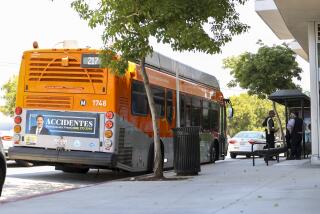Rail Spur Has No Sensors : Trains: Electronic monitoring system would have been able to detect runaway freight car that traveled 16 miles before hitting two locomotives.
- Share via
A heavily traveled railroad spur in the northeastern San Fernando Valley, where a runaway freight car rolled for 16 miles Monday until it struck two locomotives, is not equipped with sensors that would have alerted dispatchers to take emergency action, officials said Wednesday.
Trains on the track between Pacoima and Glendale are monitored only by radio communication between the dispatcher and the train’s conductor, said Southern Pacific Transportation Co. spokesman Mike Brown.
As a result, railroad dispatchers did not learn that the runaway--a hopper car filled with sand--was on the loose until an anonymous caller alerted the Los Angeles Police Department’s Foothill Division and officers notified the railroad.
Only two minutes later, the runaway car struck two locomotives, causing approximately $48,000 damage and slightly injuring one railroad worker when he jumped from a locomotive before the impact.
The railroad’s most heavily used tracks are monitored by a system called centralized traffic control, in which electronic sensors can detect the presence of a train within a particular block, registering it on a large screen.
Had this system been in place, a dispatcher could have detected the runaway car much earlier, said Ron Regenor, transportation operations supervisor for the state Public Utilities Commission, which conducted a preliminary investigation of the accident.
A federal official said railroads are not required to use the centralized tracking system, although most install it on major routes.
“It would be nice if every train system were under automatic control, but it’s not practical in every situation,” said Charles Conners, rail accident investigator for the National Transportation Safety Board. “The general outlook of the railroads is that, within economic reason, they would like to automate.”
The electronic systems are “very, very expensive, and they are very, very reliable,” he said.
Brown said the railroad has not decided whether to install sensors on the spur where the accident occurred, but will add a caboose with an additional conductor on trains for security.
Brown said that although major portions of Southern Pacific track have the centralized traffic control system, such automation is too expensive to install on all tracks. Installing sensors along the spur would cost $55 million.
Officials of the Federal Railroad Administration and the National Transportation Safety Board said there will be no further investigation.
More to Read
Sign up for Essential California
The most important California stories and recommendations in your inbox every morning.
You may occasionally receive promotional content from the Los Angeles Times.










